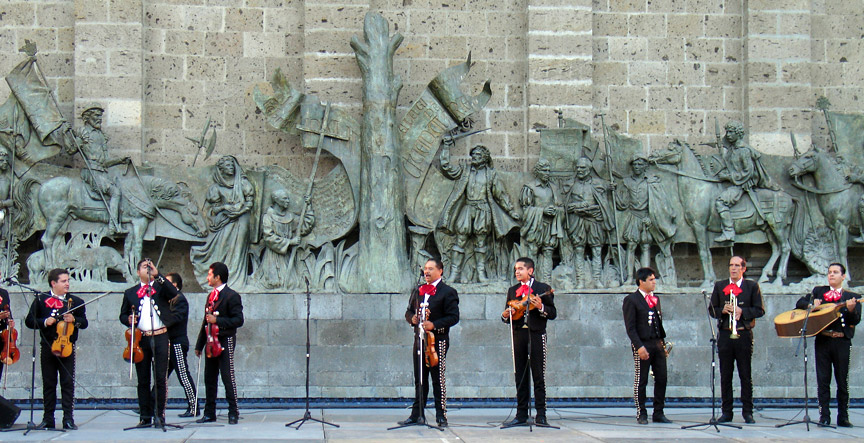A tour down town Guadalajara historic District
478 years ago, sixty-three young heads of families gathered at what is now known as Founders Square, and swore by his honor never checked out the new villa.
Contemplating the beautiful bronze relief at funders Plaza that recalls the fact, we can hear their voices and know their names. Cristobal de Oñate and Miguel de Ibarra, along with the courageous Beatriz Hernandez – “the Kings my cock” – remain vigilant witnesses the oath of our grandparents meet the new generations.
A long band across tip to tip the monument contains the history and memory Guadalajara, names and regions of the founding fathers: highlanders, Andalusia, Extremadura, Castilians, Basques, Portuguese, etc., whose mixture created the character hospitable, generous, cheerful and hardworking of Guadalajara.
For centuries, the Old Town Square was the scene of everything from weekly tianguis, which coined the term that distinguishes today’s children Guadalajara-Guadalajara-up military parades and executions of miscreants. In the last century, a governor came to build on it a coliseum of such magnificence that was pride and honor of the city.
With quarries, rocks and stones of the ruined convent of nuns and friars was lifting the Teatro Alarcon would be, but as fate would have his promoter-Santos Degollado, died in one of the thousand battles of the War of Reform, and so his name was immortalized in his work, as the Teatro Degollado still remembers.
All theaters have his ghost, his legend, and this is no exception. They say the fables that sacred stones have been used in its construction, was threatened with the curse that falls apart when the bronze eagle which crowns the center of the great arc of the forum release the chains that held between claws and beak. Fortunately, this has not happened.
Our steps are now heading to the old building of the Court, first, and then state government: the Government Palace.
It inhabited the pompous governors of New Galicia, also stayed the priest Miguel Hidalgo y Costilla deliverer and hence came to be defeated in the last battle of the independence period.
Then they occupied the governor of the new state of Jalisco, was the seat of the federal government when the hermetic Benito Juarez and his cabinet fled the conservative troops Miramon and Marquez was staged here the only time the nearly Meritorious be shot, but “the brave do not murder!” said Guillermo Prieto platoon and saved the president’s life.
The oldest and most traditional of Guadalajara, which is its historic center, which houses the oldest and admired civil and ecclesiastical buildings, no longer has commercial importance since the early years of its foundation, in the sixteenth century.
It was from the last third of the nineteenth century when they settled in the Historic Center’s first department store, owned by foreigners, so that since the beginning of the XX city stores covering widely the needs and tastes of its inhabitants. However, the commercial tradition comes from many years ago.
Besides this palace, in the center we find the most representative building of the city, the Cathedral, and building more balanced and beautiful of all: the old St. Joseph’s Seminary, now a museum.
This brief is part of the ride that visitors should not miss, especially if you do in a typical calender and allows the driver to tell the old stories that inhabit the historic center of Guadalajara.
Towards the 60s of last century, when the city reached its first million inhabitants, organized trade began to spread outside the first box, but continued to operate there many stores like The Super, Canadian Footwear, Furniture Hernan Pardo, The Doll, tlapalería the Central, Drugstore Levy, Casa Prieto, Carlos Moya, Chalita, the Steam, The city of Prague, New Market and White, while maintaining recreational facilities such as the Source, one of the oldest bars in town, and even opened new businesses.
In other words, despite the expansion of the metropolis, which today is home to three and a half million people, the historic center not only did not reduce their commercial appeal, but strengthened the tour with works like the Tapatía, the early 80
Apart from its commercial importance, the first box also offers visitors the beauty of its buildings and works of art that they housed, such as: Palacio de Gobierno, Catedral Metropolitana, Legislative Palace, Degollado Theater, Palace of Justice and Hospicio Cabanas, among others, which are surrounded by beautiful squares.
In conclusion, whoever visits downtown Guadalajara today can claim to know the city if you spend at least one day exploring its historic center, within modernity that is as interesting as centuries ago.

